11 Super easy steps to hitting your sales quota

Setting sales quotas can be difficult, but it’s essential to ensure you set up your team for success. Successful sales teams set goals and quotas that sales managers can monitor to ensure they are on the right track. This blog post will give you the keys to setting quotas and empowering your team with the resources they need to succeed.
Learn how to set sales quotas and communicate effectively with your team. Scroll down for more details.
What is a sales quota?

A sales quota is a goal-setting process that the company sets for its employees. It could be for an individual employee or group of employees. Sales quotas can motivate individuals and teams to increase production, but they can regulate the workforce.
Is there a difference between a sales quota and a sales goal? Yes.
Sales quota vs. sales goal
A sales quota is a specific number of units or products that a salesperson has to sell to reach their monthly, quarterly, or annual goal. For example, if the company’s monthly goal for this quarter is five thousand dollars worth of product, someone who sells three thousand dollars’ worth might still have not reached their quota.
A sales goal is what a company or a sales rep wants to achieve based on past performance in the previous year or quarter. That’s why a business has revenue forecasts.
For example, your company grows by 10% yearly and closed deals worth $100,000 in the last month this quarter. Your total sales forecast is $ 110,000 for this month.
On the other hand, a sales quota is what a salesperson should contribute to the company’s revenue goal for over a given period. In our example, the sales goal is $110,000, and the SDR’s sales quota could be 10% of that. The quota is fixed and tied to the seller’s compensation plan.
What about a sales target and a sales quota?
Sales target vs. sales quota
A sales target is team-based rather than individualized, like a sales quota. It’s more specific as it spells out the number of products your sales team must sell to hit the income goal in a period. Targets help you know what you need to do to reach your sales quota or goal.
Why are sales quotas important?
Sales quotas can be a great way to motivate your sales team and focus on their efforts. It’s essential to set realistic quotas that suit your company’s needs and incentivize your team members to strive for them. When you’re working towards a collective goal, it’s easier to achieve success on an individual level.
Quotas are an effective way to measure sales performance. They allow employees to feel like they are making progress and push them to sell more. Some people may take it as a personal challenge to meet their quota. Others may feel pressured and stressed about competition with other co-workers.
A sales quota is a predetermined goal a salesperson must achieve at a given time. As a result, it provides a sense of accomplishment and fosters motivation.
Sales quotas can also offer an incentive for employees to work harder or find new ways to increase their sales. But a sales quota limits how many units of a product or service you can sell in a given period.
Types of sales quotas
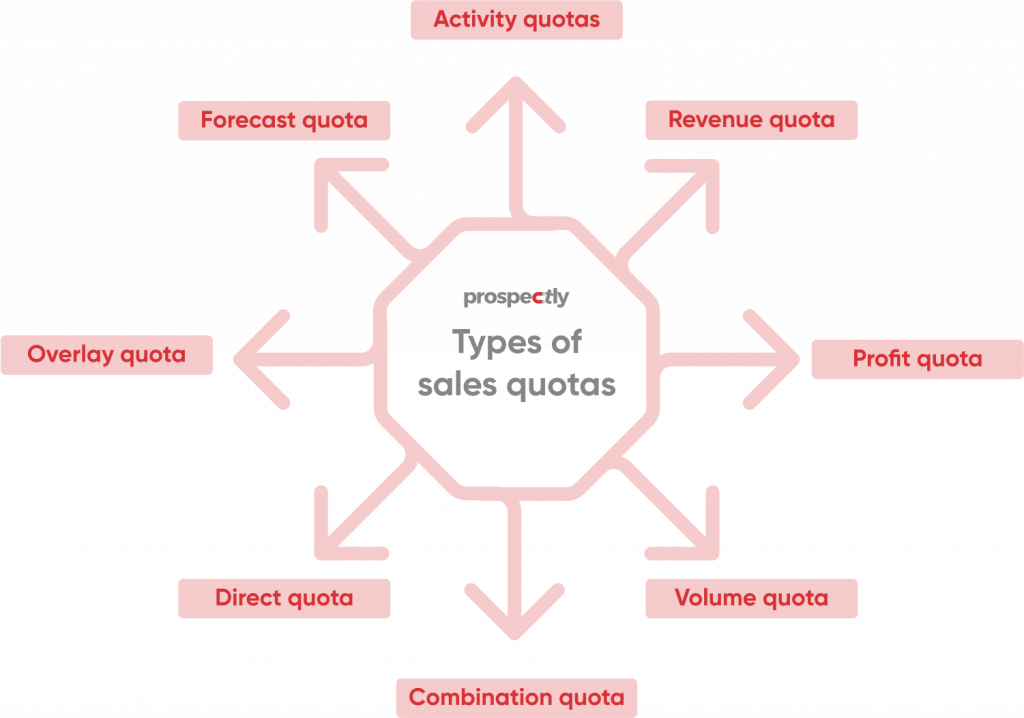
What are the eight types of quotas?
1. Activity quotas
Activity quotas require your salespeople to complete a specific number of tasks over a month or a quarter. Most of these activities have an indirect effect on sales. Examples include follow-ups, cold calls, emails, booking monthly meetings, CRM admin tasks, presenting demos, etc.
SDRs and BDRs are responsible for the activity quotas to support their sales organization’s selling efforts and individual reps.
2. Revenue quota
Your company can also assign quotas to sellers based on the revenue amount they should bring in over a given period. You reward reps according to the sales they’ve made per month or quarter. For example, you can incentivize a salesperson for a single deal that leads to significant revenue in that month.
3. Profit quota
This type of quota is similar to a revenue quota. However, the difference is that you base the profit quota on the net sales activity income. It means that you deduct selling expenses from gross revenue to determine the rep’s profit quota.
4. Volume quota
You can encourage your salesforce to sell more of your product or service packages by using a volume quota. Each seller receives an incentive according to the product units sold, generated qualified leads, etc.
5. Combination quota
Another way to make your reps’ work manageable and thriving is by allocating a combination quota. It includes two or more quotas, such as a revenue and profit quota. Multiple quotas increase the seller’s chance of meeting their sales objectives.
6. Direct quota
Typically, you assign a direct quota to top salespeople who need to take full responsibility for their selling activities. These individuals make things happen to ensure they succeed in reaching or exceeding their numbers. Business quotas based on conversion rates or average selling price and customer quotas are examples of a direct quota.
7. Overlay quota
An overlay quota is the total of all direct quotas. For example, a sales manager has an overlay quota, including sellers’ direct quotas under them. Also, the VP has an overlay quota totaling the sales leaders’ direct quotas.
8. Forecast quota
It’s also possible to use a forecast quota which is a team or territory-based quota. You can calculate this metric by considering the previous revenue of a region or team.
Setting sales quotas
You can create sales quotas in two ways: a top-down or bottom-up sales approach.
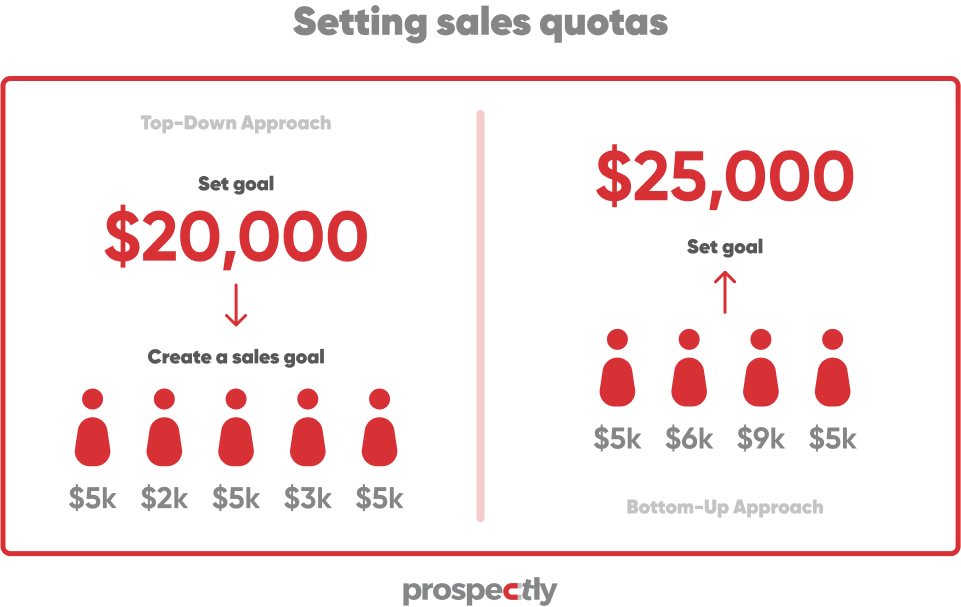
1. Top-down approach
Executives and sales managers use the top-down method to determine sales quotas according to what the company wants to earn. For this approach, you consider the following:
- Market trends
- Competitors
- Historical revenue data
- Desired business growth
In our first example, you set a sales goal of $20,000 per month or quarter for your company. You then distribute the revenue goal among four reps, bringing in $5k as their quota. A seller can also figure out the number of deals they need to close per month to hit their quota if they know the average sale size.
Example: An average deal size of $500 means that a salesperson should close 40 sales before month-end ($20k/$500).
2. Bottom-up approach
A bottom-up method involves setting quotas based on the seller’s previous performance. You consider what each sales rep can achieve in a given period to set realistic quotas. As a result, the method can motivate your salespeople and incentivize sales leaders.
One way of using the bottom-up strategy is looking at the number of deals your seller can make in a month. What was the win rate for the rep in the past month? Then, multiply that sales number by the average deal size.
Example: A salesperson closes ten deals per month. The average deal size is $500, and the reps’ sales quota is $5,000 for this month (10 x $500).
Sales quota calculators
How do you calculate a sales quota? You can use sales calculators to figure out the quotas for your salesforce. Check out the following examples.
Sales quota calculator 1
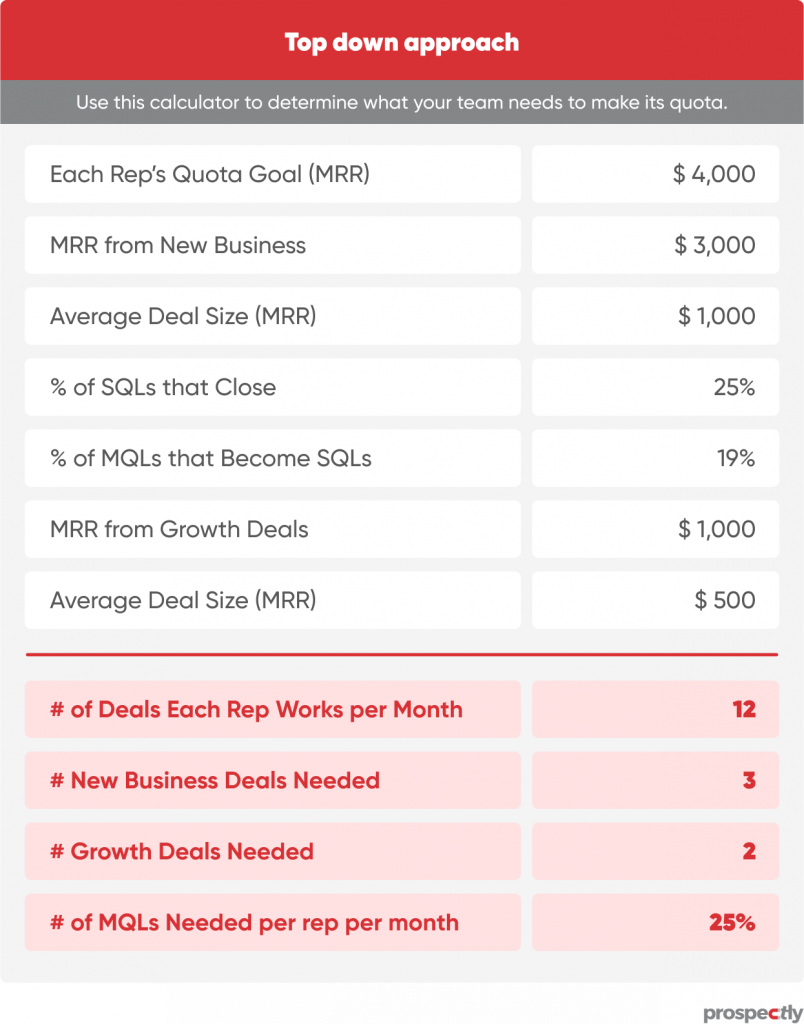
Sales quota calculator 2
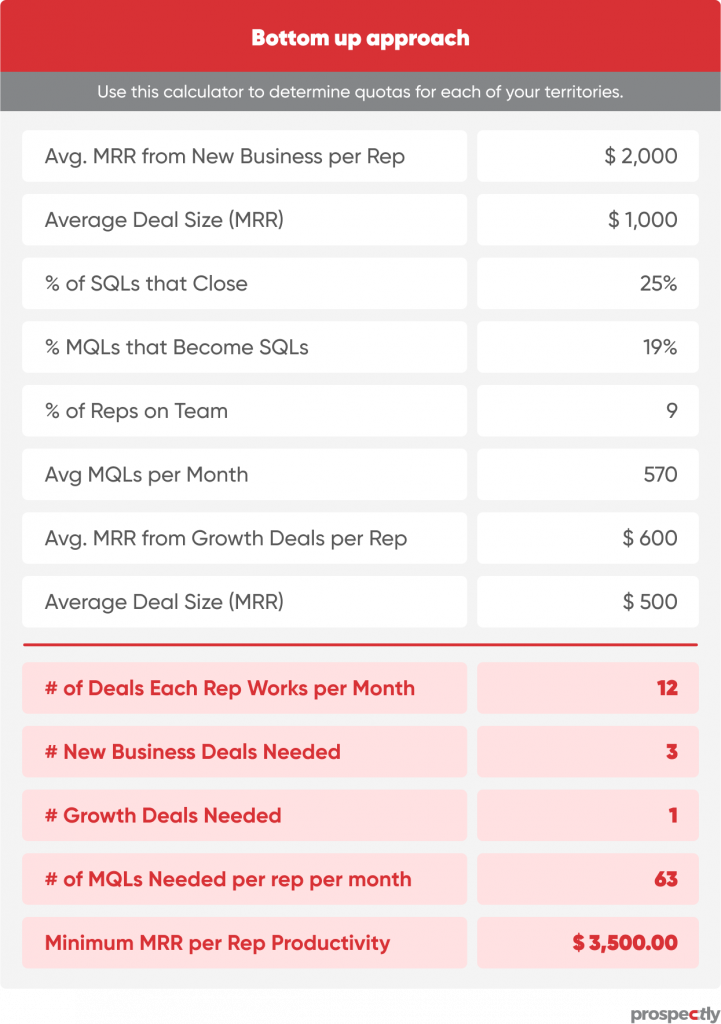
Sales quota calculator 3
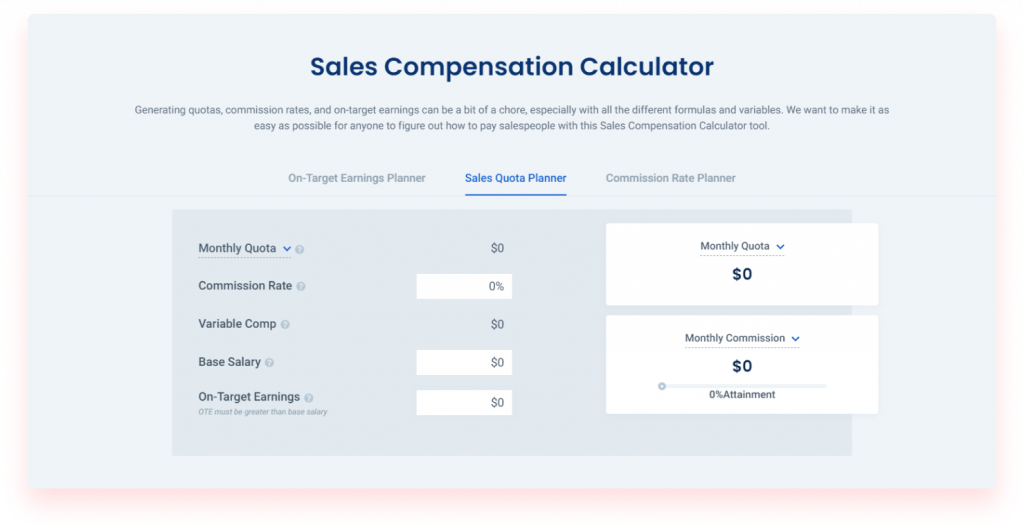
11 Best tips for always hitting your sales quota

How can you set effective quotas and always hit your numbers? Check out the following strategies. The first five tips help sales managers establish successful quotas, and the last six techniques are ideal for crushing your metrics.
1. Sales quotas must follow sales activities
Earlier, we talked about eight kinds of quotas. The best strategy for determining sales quotas is aligning them with sales activities. That’s because your reps have direct control over these tasks compared to gross-margin-based quotas. Also, they can’t influence discounts or markups.
2. Quotas should encourage positive behavior in the process
One risk of focusing too much on the outcome of quotas is that sellers may take shortcuts to crush their numbers. It promotes bad selling habits. Instead, a better situation is where reps follow their sales plans or the company’s preferred approach.
For example, sellers need to stick to one approach if they choose a customer-centric sales model to build customer relations and repeat clients. Reps should zero in on developing those relationships to perfect their art and make more sales.
3. You should develop quotas with others
We also mentioned two methods of assigning quotas to your salesforce: top-down and bottom-up. The better approach should be inclusive because every stakeholder has a chance to air their views. Sellers can shed more light on the current market environment in different regions. Also, the finance staff has expert knowledge about trends, forecasts, and data they can share with the team.
4. Leave yesterday’s quota in yesterday’s sales report
You could transfer previous allocations to the current month because your company was successful last quarter. But, it shouldn’t be the case due to changing buying patterns and market conditions. The best thing is to adjust your sales numbers depending on the local business environment.
5. Avoid depending on previous achievements
Another problem related to the above observation is relying on past sales performance to determine each seller’s quota. It could be a good move but ignores current factors that can make or break your success rate.
You may double an individual’s numbers for this quarter based on their previous sterling results in a specified sales field. However, yesterday’s achievement doesn’t guarantee today’s outcome. Because of this, it’s critical to think through your sales quotas before you dish them out.
6. Maintain a full pipeline.
Focusing on sales with a high potential to close is a good tactic, but you can harm your sales pipeline. What happens when your deals sail through? You remain with an empty pipeline and loss of business opportunities.
Instead, ensure that you maximize every deal at each sales process stage to keep customers streaming down the funnel. Ensure that your sales pipeline is bursting with potential customers by consistently prospecting leads.
7. Establish a referral program.
You can hit your sales quota by taking advantage of referrals from customers you served well. Develop a referral process of reaching out to your key decision-makers, present buyers, and their circle of industry peers and professionals. It helps you build robust relations that can lead to ballooning sales.
CRM automation tools can help in creating a referral process.
8. Reconnect with missed opportunities.
One of the challenges in sales is winning new customers-it’s an uphill activity. You can speed up the sales cycle by reconnecting with prospects who have previously declined. They can open up and give you another chance since you’ve interacted with them before. As a result, you can develop new opportunities faster.
Related: Sales Cadence: How To Create the Best Cadence That Lands Meetings
9. Be sure to consider renewals and upsells
Upselling and reselling to your current customers is another quick way to rock your sales numbers. However, you should add value to your buyers by educating them with helpful content or offering them other resources. It enables you to nurture relations and recommend additional products or packages. Also, upsell to your clients as soon as they purchase something.
10. Use creative prospecting techniques.
Traditional prospecting methods include thought leadership, emails, cold calls, etc. But you need to be creative if you want to stand out from the crowd and be a champ on your team. For example, instead of qualifying prospects, try disqualifying them. It means you stop chasing after every opportunity, but rather, focus on the ones with potential.
11. Keep an eye on your metrics
Here are the primary metrics you need to monitor to crush your sales quotas using your preferred CRM.
Sales activity metrics include the rate of activities and follow-up activities. For the first metric, track the number of emails sent and the phone calls made monthly or quarterly. Also, assess the conversion and response rate of these activities.
The rate of follow-up activities looks at how well your sales team is winning more deals by pursuing prospects. They’re vital because most sales need consistent follow-ups.
Sales managers should also keep tabs on sales pipeline metrics. They show your team’s ability to reach out to customers. Examples of pipeline stats include the number of open opportunities, average days in each opportunity stage, stage to stage conversion rates, and opportunity rate.
Checking how much time your reps invest in prospecting and qualifying is crucial. That’s because it determines the number of open opportunities and deals size and the sellers’ success in hitting their quotas. You can follow which deals have a high chance to close by evaluating the average number of days in each opportunity stage.
How are your salespeople performing at each stage? Do they need sales coaching to up their game? You can know this by assessing the stage-to-stage conversation rate. Also, you should check the opportunity win rate to see if reps can move prospects to closing deals.
Wrapping up
Sales quotas tied to your compensation plan can motivate your salespeople to excel, leading to skyrocketing revenue. It’s vital to involve every key person in your sales team to set effective quotas. Sales quotas should take into account current buying patterns. Tracking your metrics with CRM software ensures you make data-driven decisions.
Related: How to build a failure-proof sales funnel to win customers




